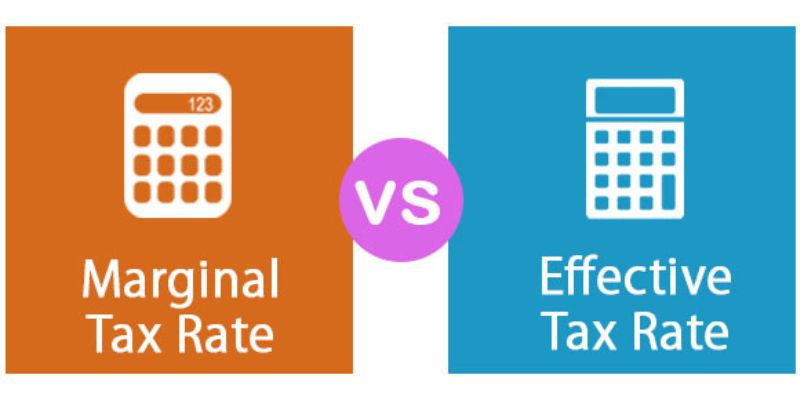Effective vs. Marginal Tax Rate
Dec 29, 2023 By Triston Martin
Taxes can be confusing, and understanding the difference between effective and marginal tax rates is fundamental for individuals to make smart decisions about their financial future.
In this blog post, we'll focus on breaking down the concepts of effective vs. marginal tax rate so you can better understand how taxes may impact your overall income strategy. We will review what these terms mean, how they are calculated, and strategies that might be beneficial when navigating knowledgeably through our complex US tax system.
What Is an Effective Tax Rate?
An effective tax rate is the average rate of taxation that you you're income, considering all deductions and credits. It is calculated by dividing the total taxes paid by your taxable income for the year. For example, if you made a taxable income of $50,000 in a year and paid $7,500 in taxes, then your effective tax rate would be 15%, which is ($7,500/$50,000).
Due to the possibility that your income will be subject to many tax brackets in a given year, your effective tax rate will typically be lower than your marginal tax rate. Different deductions or credits may be applied based on taxable income levels to lower the overall amount owed. For instance, deductions for things like mortgage interest payments, charitable contributions, and medical costs may lower your taxable income and consequently lower the amount of taxes you owe. Any tax credits you might get are also reflected in your effective tax rate.
Understanding how to calculate your effective tax rate is important for you to know what portion of your income is being taxed each year.
Knowing this figure can help individuals make more informed decisions about their financial future by understanding how different scenarios could affect their overall tax burden. This knowledge can be especially helpful when exploring options such as retirement investments or other strategies that could minimize the amount of taxes owed over time.
What Is a Marginal Tax Rate?
A marginal tax rate is the rate of taxation applied to each additional dollar of income you make. It is determined by the highest tax bracket that your taxable income falls into, and it is used to calculate how much taxes you will owe on any additional money earned.
For example, if your taxable income places you in the 12% tax bracket for 2020, then every additional dollar you earn over that amount would be taxed 12%. So if you made $50,000 and paid $7,500 in taxes, each additional dollar earned after the first $50k will be taxed 12%.
Marginal tax rates are progressive, increasing as your total taxable income increases. The US tax system has seven marginal tax rate categories ranging from 10% to 37%, so the amount of taxes you owe will depend on your income level and how it is taxed.
Since marginal tax rates are applied only to extra income, they can affect decisions about how much money someone can earn and in what format (such as wages or investments). For example, if an individual earns $50,000 annually and the next dollar earned would be taxed higher than their effective tax rate, it may make sense for them to invest money rather than just take home additional wages.
Examples of a Marginal Tax Rate
1. 10%: This is the lowest marginal tax rate and applies to those with taxable income up to $9,875 in 2020.
2. 12%: This marginal tax rate applies to incomes between $9,876 - $40,125 in 2020.
3. 22%: This is the third largest marginal tax bracket and applies to taxable incomes between $40,126 - $85,525 in 2020.
4. 24%: The fourth highest marginal tax rate applies to incomes between $85,526 - $163,300 in 2020.
5. 32%: This is the fifth highest marginal tax bracket and applies to taxable incomes between $163,301 - $207,350 in 2020.
Examples of an Effective Tax Rate
1. 10%: This is the effective tax rate for those with a taxable income of $9,875 or less in 2020.
2. 15%: This rate applies to incomes between $9,876 -$40,125 in 2020.
3. 19%: The third highest effective tax rate applies to those with incomes between $40,126 - $85,525 in 2020.
4. 22%: The fourth highest effective tax rate applies to taxable incomes between $85,526 - $163,300 in 2020.
5. 25%: This is the fifth highest effective tax rate, and it applied to incomes between $163,301 - 207,350 in 2020.
How Federal Tax Brackets Work
The federal tax brackets are the system the US government uses to determine how much taxes an individual owes based on their taxable income. The Internal Revenue Service (IRS) breaks down taxpayers into seven categories for 2020, each with its marginal tax rate and corresponding effective tax rate. It is important to understand how these brackets work to maximize savings from deductions or credits that may be available.
Taxable income is determined by subtracting any deductions you qualify for from your gross income. Depending on your filing status, there are different levels of deductions allowed and some additional deductions such as those related to health care coverage, student loan interest, or a foreign earned income exclusion.
Once taxable income has been calculated, it is broken down to determine the applicable tax rate. The US government has seven income brackets for 2020, each with marginal and effective tax rates. Generally speaking, the higher your taxable income bracket, the higher your marginal and effective tax rates will be.
Tips for Using Marginal and Effective Tax Rates
Know your taxable income:
Make sure to calculate your total taxable income for the year, as this will determine which tax bracket you fall into and what marginal and effective tax rates apply.
Utilize deductions and credits:
Take advantage of any deductions or credits you are eligible for to reduce your taxable income and therefore minimize the taxes owed.
Consider retirement investments:
Investing money into a retirement account is a great way to save on taxes now while allowing it to grow over time, potentially minimizing future taxation burdens.
Analyze when taking extra pay:
Consider whether other investment strategies could benefit you if an additional dollar earned would be taxed more than your effective tax rate.
Compare filing statuses:
Different filing statuses can significantly affect the amount of taxes owed, so consider if it would be more beneficial for you to file jointly or separately when applicable.
Choose investments wisely:
Investing in certain vehicles, such as mutual funds or ETFs rather than company stocks, can provide tax advantages that may lower your effective tax rate over time.
Understand different state rules:
State income taxes also play a role in determining your overall taxation burden, so research the various requirements and rates that apply where you live.
Take advantage of business deductions:
If you own a business, there are certain deductions that you can use to reduce your taxable income and therefore lower the amount of taxes owed.
FAQs
Should I use the effective tax rate or the marginal tax rate?
It is important to understand both marginal and effective tax rates as they are used to determine taxes owed. However, the effective tax rate determines the actual amount of taxes paid, so this should be the focus when making strategic financial decisions.
What are the US federal tax brackets for 2020?
The US federal government has seven income tax brackets for 2020: 10%, 12%, 22%, 24%, 32%, 35% and 37%. Knowing where your taxable income falls is important to determine which rate applies.
How can I figure out what my marginal tax rate is?
Your total taxable income determines your marginal tax rate and which bracket you fall into. For example, if your taxable income places you in the 22% bracket, that is your marginal tax rate.
Conclusion
Understanding the difference between effective and marginal tax rates is key to smart financial decisions. It is important to know your taxable income, utilize deductions or credits available, invest in retirement accounts strategically, analyze when taking extra pay, compare filing statuses, choose investments wisely, and understand different state rules to minimize the amount of taxes owed while increasing savings potential.
-
 Investment Nov 11, 2023
Investment Nov 11, 2023What All Teens Should Know About Investing Vs Savings
Learning about investing vs savings early for young adults can help them make informed decisions when it comes to financial responsibility. Learn the best financial advice for young adults.
-
 Investment Nov 30, 2023
Investment Nov 30, 2023Key Advantages Of The Approach To Take Into Consideration
Once upon a time, receiving income from Social Security plus a pension was sufficient to meet one's financial needs throughout retirement. Not nearly as much as it used to. Instead, most individuals finance their own post-work years by investing in various retirement plans, many of which provide tax cuts and other perks.
-
 Investment Nov 20, 2023
Investment Nov 20, 2023IMF research shows that the system plays a key role in the financing of SMEs
In MENAP and CCA regions, the contribution of output and employment is smaller than other regions, which can be seen through the average share of SME loans.
-
 Investment Oct 11, 2023
Investment Oct 11, 2023Building Wealth: Top Picks for Best Lumber Stocks to Buy Now
If you're searching for the best lumber stocks to invest in, our investor's guide has got you covered. Discover the best picks today!
